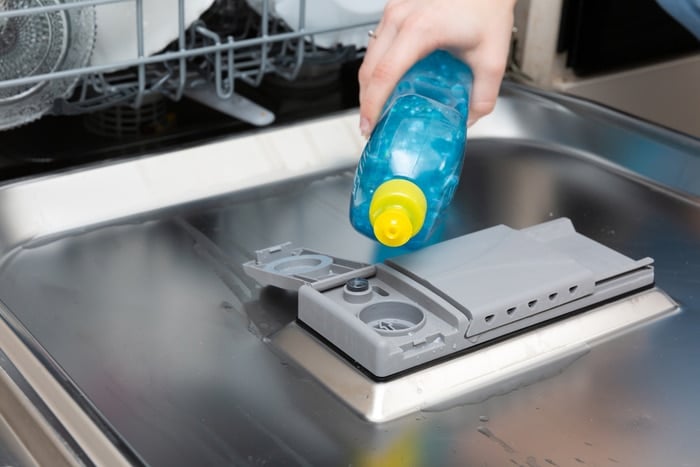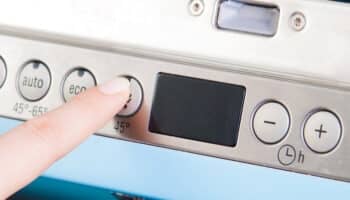Is your dishwasher’s rinse aid not dispensing?
I’ve been there too! I understand how frustrating it can be to open the dishwasher and find that your glasses have water spots or aren’t completely dry.
The good news is that you’ve come to the right place to fix the issue.
If your dishwasher’s rinse aid isn’t releasing properly, you’ll need to check the rinse aid level, adjust the settings, and clean the dispenser. If the issue persists, it’s important to inspect the cap, get a replacement, or examine the control board.
Read on to fix your dishwasher’s rinse aid dispenser!
Dishwasher Rinse Aid Not Dispensing? 6 Reasons Why
In this section, I’ll walk you through the possible reasons why your dishwasher’s rinse aid isn’t releasing properly and provide various solutions.
Fixing the problem will require accessing certain internal components of your dishwasher, so it’s crucial to have the owner’s manual on hand.
Are you ready? Let’s get started!
#1 Wrong Amount of Rinse Aid
When fixing a dishwasher that is not releasing rinse aid, I always start by checking the amount of product being used.
During the final cycle of the dishwasher’s operation, a specific amount of rinse aid is automatically dispensed to prevent water spots and speed up the drying process. However, if you accidentally forget to refill the rinse aid dispenser, it won’t dispense enough product, leading to streaks and other issues.

To fix the problem, it’s important to check the rinse aid dispenser before starting a new dishwasher cycle. Simply remove the cap and fill the dispenser with rinse aid up to the maximum level.
Note: Avoid overfilling the rinse aid dispenser to prevent leaks and excessive suds.
It’s also important to refer to the manufacturer’s manual, as it typically includes recommendations on how much rinse aid to use based on your home’s water quality.
#2 Incorrect Settings
If your dishwasher’s rinse aid is still not dispensing as expected, I recommend double-checking the settings.
You see, certain modern dishwashers allow you to adjust the amount of rinse aid dispensed at the end of the cycle based on your needs. For instance, if you live in an area with hard water, you can select a higher rinse aid setting to prevent any filmy residue or spots on your dishes.
Most dishwashers have a dial typically numbered from 1 to 3 or 1 to 6. The lower the number, the less rinse aid is dispensed.
To adjust the rinse aid setting, simply turn the arrow inside the dispenser to the desired level. If you’re struggling with hard water, cloudy glassware, or drying issues, select the highest number.
Please note that the process of adjusting the rinse aid settings can vary depending on your dishwasher’s model. So, it’s important to refer to the manufacturer’s manual for detailed instructions.
#3 Dirty Rinse Aid Dispenser
In my experience, a dirty dispenser can also explain why the rinse aid is not being released properly.
After each use, a certain amount of rinse aid residue can be left behind on the dispenser. Over time, residue and mineral deposits can build up, leading to blockages that can affect the dispenser mechanism.
So, it’s essential to regularly clean your dishwasher’s rinse aid dispenser. Here’s a step-by-step guide on how to do it:
- Open the dishwasher door and locate the rinse aid dispenser.
- Carefully remove the dispenser’s cap.
- Use warm water and an old toothbrush to clean the interior walls of the rinse aid dispenser and remove the product’s residue.
- For stubborn debris, consider using vinegar. Its acidity can help break down detergent and mineral buildup.
- Rinse the compartment with warm water and dry it with a microfiber cloth.

Once you’ve cleaned the dispenser, refill it with rinse aid and put the cap back on. Be sure to clean up any spills around the dispenser.
Tip: If you haven’t cleaned your dishwasher in a while, now is a good time to do so. Simply use a tablet cleaner and run the hottest cycle. Don’t forget to clean the filter with a wire brush and give the spray arms a good clean as well to prevent performance issues.
#4 Damaged Cap
I find that when a dishwasher is not dispensing rinse aid properly, it’s typically due to a faulty cap.
The rinse aid’s cap creates a tight seal and ensures the liquid doesn’t spill. If the cap is cracked or damaged, the rinse aid will be released before the final cycle or evaporate from the dispenser.
To solve the issue, clean the cap using warm water and an old toothbrush. If you find stubborn debris, use white vinegar.
While you’re at it, please inspect the cap. Look for any signs of damage, such as cracks or wear. If necessary, replace the cap with a new, compatible one.
To ensure you get a compatible replacement, search for your dishwasher’s model number and enter it in the search bar below.
More often than not, replacing the rinse aid cap is very simple. You’ll just need to clean the area before installing the new cap and insert the replacement into the compartment. Make sure it’s securely fastened.
#5 Malfunctioning Rinse Aid Dispenser
If you’ve tried the fixes above, but your dishwasher’s rinse aid is still not releasing properly, you should consider getting a replacement.
While replacing the dispenser’s internal components is possible, it’s often more effective to replace the entire dispenser, as you’ll eliminate the need for multiple repairs and their associated costs.
Follow these simple instructions to replace your dishwasher’s rinse aid dispenser:
- Search for your dishwasher’s model number and get a compatible replacement.
- Once you have the new dispenser, unplug your dishwasher from its power source or turn it off at the circuit breaker to prevent electrical hazards. It’s also important to turn off the water supply under the kitchen sink.
- Open the dishwasher door and remove the six screws that hold the front panel in place using a screwdriver.
- Carefully lift or separate the front panel to access the detergent and rinse aid dispenser.
- Take a picture of the wiring connections for future reference. Then, disconnect the wires from the motor.
- Remove the screws that hold the dispenser in place.
- Slightly open the dishwasher door and pull the old dispenser out from the inside.
- Clean the housing area where the old dispenser was located and install the new dispenser.
- Secure the new dispenser in place using the screws you previously removed.
- Refer to the picture you took earlier to reconnect the wires to the dispenser’s motor.
- Put the front panel back into its original position.
Once you’ve replaced the detergent and rinse aid dispenser, please plug your dishwasher back into the outlet or turn it on at the circuit breaker. Then, turn on the water supply and run a quick wash cycle to see if the issue has been solved.
Remember that if you’re uncomfortable replacing your dishwasher’s rinse aid dispenser, it’s best to call a professional. They have the required tools and expertise to fix the problem.
#6 Faulty Control Board
If replacing the rinse aid dispenser didn’t solve the issue, then there’s likely an issue with the control board.
The control board is like the brain of your dishwasher. It receives signals from the unit’s sensors and communicates with the internal components to control various functions, including the detergent and rinse aid dispensing.
If the control board malfunctions, it won’t signal the dispenser to release the rinse aid at the end of the wash cycle.
To solve the problem, you’ll need to unplug your dishwasher and access the control board, which is typically located behind the control panel. Then, inspect the wiring and look for any signs of damage or loose connections.
If you determine that the control board is indeed faulty, it’s best to consult your warranty status and contact a professional.
Replacing the control board can be both expensive and challenging. So, if your dishwasher is no longer under warranty and is over ten years old, consider replacing the entire unit.
Fixing Your Dishwasher’s Rinse Aid Dispenser
That about covers it! Hopefully, now you know how to fix your dishwasher’s rinse aid dispenser.
Remember that if your dishwasher’s rinse aid is not releasing properly, you’ll need to make sure you’re using the right amount of product and adjust the settings. It’s also important to clean the dispenser and inspect the cap.
However, if the issue persists, don’t forget to replace the rinse aid dispenser or check the control board.
Thank you so much for taking the time to read this article. If you’ve found it helpful, please check out our other related guides below.
Good luck!









